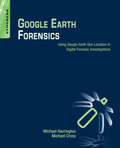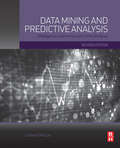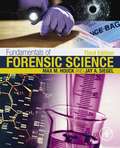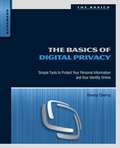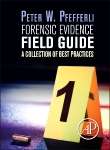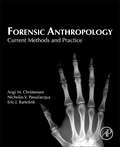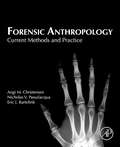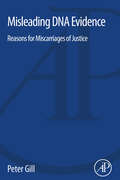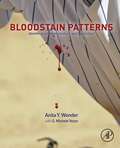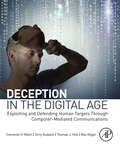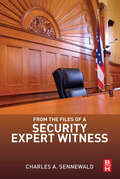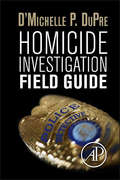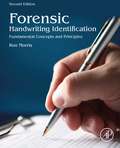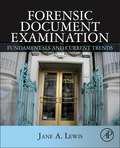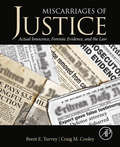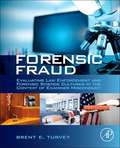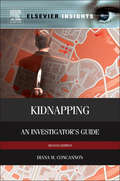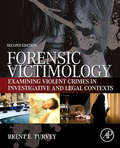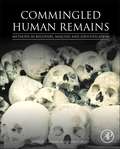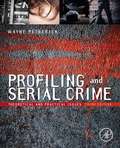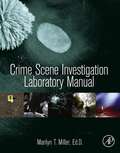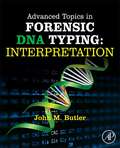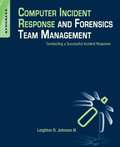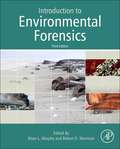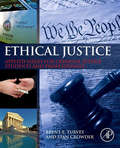- Table View
- List View
Google Earth Forensics: Using Google Earth Geo-Location in Digital Forensic Investigations
by Michael Harrington Michael CrossGoogle Earth Forensics is the first book to explain how to use Google Earth in digital forensic investigations. This book teaches you how to leverage Google's free tool to craft compelling location-based evidence for use in investigations and in the courtroom. It shows how to extract location-based data that can be used to display evidence in compelling audiovisual manners that explain and inform the data in contextual, meaningful, and easy-to-understand ways. As mobile computing devices become more and more prevalent and powerful, they are becoming more and more useful in the field of law enforcement investigations and forensics. Of all the widely used mobile applications, none have more potential for helping solve crimes than those with geo-location tools. Written for investigators and forensic practitioners, Google Earth Forensics is written by an investigator and trainer with more than 13 years of experience in law enforcement who will show you how to use this valuable tool anywhere at the crime scene, in the lab, or in the courtroom.Learn how to extract location-based evidence using the Google Earth program or app on computers and mobile devicesCovers the basics of GPS systems, the usage of Google Earth, and helps sort through data imported from external evidence sourcesIncludes tips on presenting evidence in compelling, easy-to-understand formats
Data Mining and Predictive Analysis: Intelligence Gathering and Crime Analysis
by Colleen McCueData Mining and Predictive Analysis: Intelligence Gathering and Crime Analysis, 2nd Edition, describes clearly and simply how crime clusters and other intelligence can be used to deploy security resources most effectively. Rather than being reactive, security agencies can anticipate and prevent crime through the appropriate application of data mining and the use of standard computer programs. Data Mining and Predictive Analysis offers a clear, practical starting point for professionals who need to use data mining in homeland security, security analysis, and operational law enforcement settings. This revised text highlights new and emerging technology, discusses the importance of analytic context for ensuring successful implementation of advanced analytics in the operational setting, and covers new analytic service delivery models that increase ease of use and access to high-end technology and analytic capabilities. The use of predictive analytics in intelligence and security analysis enables the development of meaningful, information based tactics, strategy, and policy decisions in the operational public safety and security environment.Discusses new and emerging technologies and techniques, including up-to-date information on predictive policing, a key capability in law enforcement and securityDemonstrates the importance of analytic context beyond softwareCovers new models for effective delivery of advanced analytics to the operational environment, which have increased access to even the most powerful capabilitiesIncludes terminology, concepts, practical application of these concepts, and examples to highlight specific techniques and approaches in crime and intelligence analysis
Fundamentals of Forensic Science
by Max M. Houck Jay A. SiegelFundamentals of Forensic Science, Third Edition, provides current case studies that reflect the ways professional forensic scientists work, not how forensic academicians teach. The book includes the binding principles of forensic science, including the relationships between people, places, and things as demonstrated by transferred evidence, the context of those people, places, and things, and the meaningfulness of the physical evidence discovered, along with its value in the justice system. Written by two of the leading experts in forensic science today, the book approaches the field from a truly unique and exciting perspective, giving readers a new understanding and appreciation for crime scenes as recent pieces of history, each with evidence that tells a story. Straightforward organization that includes key terms, numerous feature boxes emphasizing online resources, historical events, and figures in forensic scienceCompelling, actual cases are included at the start of each chapter to illustrate the principles being coveredEffective training, including end-of-chapter questions – paired with a clear writing style making this an invaluable resource for professors and students of forensic scienceOver 250 vivid, color illustrations that diagram key concepts and depict evidence encountered in the field
The Basics of Digital Privacy: Simple Tools to Protect Your Personal Information and Your Identity Online
by Denny CherryWho’s watching you online? These days, it’s hard to be sure. But the recent Edward Snowden revelations of NSA data mining and the constant threat of identity theft from criminals mean your privacy is in jeopardy. The Basics of Digital Privacy teaches you how to protect the privacy of your data and your identity while surfing, searching, and interacting with others in a virtual world. Author Denny Cherry teaches professionals how to keep huge databases secure, and he will introduce you to the basic concepts of protecting your identity, your financial data, and your personal information from prying eyes while using your computer and smartphone. You’ll learn how to stay connected and conduct business online, while protecting your privacy with every keystroke and click. The Basics of Digital Privacy gives you clear, non-technical explanations of how to safely store personal information online, create secure usernames and passwords for websites, and participate in social media without compromising your privacy. Learn how to find out who’s watching you online, and what the law has to say about your privacy rights. A great resource for anyone who ventures into the online world on a daily basis!The most straightforward and up-to-date guide to privacy for anyone who goes online for work, school, or personal useReal-world examples show you how cyber criminals commit their crimes, and what you can do to keep your identity and your data safeWritten by author Denny Cherry, who teaches top security professionals how to protect huge databases of informationLearn the best ways to create secure passwords, chat, text, email and conduct business online without compromising your identity and your personal data
Forensic Evidence Field Guide: A Collection of Best Practices
by Peter PfefferliForensic Evidence Field Guide: A Collection of Best Practices highlights the essentials needed to collect evidence at a crime scene. The unique spiral bound design is perfect for use in the day-to-day tasks involved in collecting evidence in the field. The book covers a wide range of evidence collection and management, including characteristics of different types of crime scenes (arson, burglary, homicide, hit-and-run, forensic IT, sexual assault), how to recover the relevant evidence at the scene, and best practices for the search, gathering, and storing of evidence. It examines in detail the properties of biological/DNA evidence, bullet casings and gunshot residue, explosive and fire debris, fibers and hair, fingerprint, footprint, and tire impression evidence, and much more. This guide is a vital companion for forensic science technicians, crime scene investigators, evidence response teams, and police officers.Unique Pocket Guide design for field workBest practice for first evidence responders Highlights the essentials needed to collect evidence at a crime scene Focus on evidence handling from documentation to packaging
Forensic Anthropology: Current Methods and Practice (PDF)
by Angi M. Christensen Nicholas V. Passalacqua Eric J. BartelinkForensic Anthropology: Current Methods and Practice-winner of a 2015 Textbook Excellence Award (Texty) from The Text and Academic Authors Association-approaches forensic anthropology through an innovative style using current practices and real case studies drawn from the varied experiences, backgrounds, and practices of working forensic anthropologists. This text guides the reader through all aspects of human remains recovery and forensic anthropological analysis, presenting principles at a level that is appropriate for those new to the field, while at the same time incorporating evolutionary, biomechanical, and other theoretical foundations for the features and phenomena encountered in forensic anthropological casework. Attention is focused primarily on the most recent and scientifically valid applications commonly employed by working forensic anthropologists. Readers will therefore learn about innovative techniques in the discipline, and aspiring practitioners will be prepared by understanding the necessary background needed to work in the field today. Instructors and students will find Forensic Anthropology: Current Methods and Practice comprehensive, practical, and relevant to the modern discipline of forensic anthropology. Winner of a 2015 Most Promising New Textbook Award from the Text and Academic Authors Association Focuses on modern methods, recent advances in research and technology, and current challenges in the science of forensic anthropology Addresses issues of international relevance such as the role of forensic anthropology in mass disaster response and human rights investigations Includes chapter summaries, topicoriented case studies, keywords, and reflective questions to increase active student learning
Forensic Anthropology: Current Methods and Practice
by Angi M. Christensen Nicholas V. Passalacqua Eric J. BartelinkForensic Anthropology: Current Methods and Practice—winner of a 2015 Textbook Excellence Award (Texty) from The Text and Academic Authors Association—approaches forensic anthropology through an innovative style using current practices and real case studies drawn from the varied experiences, backgrounds, and practices of working forensic anthropologists. This text guides the reader through all aspects of human remains recovery and forensic anthropological analysis, presenting principles at a level that is appropriate for those new to the field, while at the same time incorporating evolutionary, biomechanical, and other theoretical foundations for the features and phenomena encountered in forensic anthropological casework. Attention is focused primarily on the most recent and scientifically valid applications commonly employed by working forensic anthropologists. Readers will therefore learn about innovative techniques in the discipline, and aspiring practitioners will be prepared by understanding the necessary background needed to work in the field today. Instructors and students will find Forensic Anthropology: Current Methods and Practice comprehensive, practical, and relevant to the modern discipline of forensic anthropology. Winner of a 2015 Most Promising New Textbook Award from the Text and Academic Authors AssociationFocuses on modern methods, recent advances in research and technology, and current challenges in the science of forensic anthropologyAddresses issues of international relevance such as the role of forensic anthropology in mass disaster response and human rights investigationsIncludes chapter summaries, topicoriented case studies, keywords, and reflective questions to increase active student learning
Misleading DNA Evidence: Reasons for Miscarriages of Justice
by Peter GillMisleading DNA Evidence: A Guide for Scientists, Judges, and Lawyers presents the reasons miscarriages of justice can occur when dealing with DNA, what the role of the forensic scientist is throughout the process, and how judges and lawyers can educate themselves about all of the possibilities to consider when dealing with cases that involve DNA evidence. DNA has become the gold standard by which a person can be placed at the scene of a crime, and the past decade has seen great advances in this powerful crime solving tool. But the statistics that analysts can attach to DNA evidence often vary, and in some cases the statistical weight assigned to that match, can vary enormously. The numbers provided to juries often overstate the evidence, and can result in a wrongful conviction. In addition to statistics, the way the evidence is collected, stored and analyzed can also result in a wrongful conviction due to contamination. This book reviews high-profile and somewhat contentious cases to illustrate these points, including the death of Meredith Kercher. It examines crucial topics such as characterization of errors and determination of error rates, reporting DNA profiles and the source and sub-source levels, and the essentials of statement writing. It is a concise, readable resource that will help not only scientists, but legal professionals with limited scientific backgrounds, to understand the intricacies of DNA use in the justice system.Ideal reference for scientists and for those without extensive scientific backgroundsWritten by one of the pioneers in forensic DNA typing and interpretation of DNA profiling resultsIdeal format for travel, court environments, or wherever easy access to reference material is vital
Bloodstain Patterns: Identification, Interpretation and Application
by Anita Y. WonderBloodstain Patterns: Identification, Interpretation and Application combines material from Blood Dynamics (2001) and Bloodstain Pattern Evidence (2007) with updated case work and scientific advances from medical and hard sciences. The text expands coverage of such areas as arterial damage pattern identification, staging of crime scenes, legal applications and problems from both sides of the bench, and extending teaching and training to those outside criminal justice. With violent offenders more aware of crime scene investigation techniques and attempting to frame others, the text expands outdated basic training programs that are insufficient to identify attempts to confuse the investigation. This book clarifies previous understandings as well as bridges the gap toward future advance courses. Based on the work of Paul Leland Kirk, the book’s focus is on first line investigators’ accuracy in identifying specific bloodstain patterns, correctly interpreting and applying them to casework.Combines and updates material from Blood Dynamics and Bloodstain Pattern Evidence into one comprehensive referenceCovers new topics, including arterial damage pattern identification, staging of crime scenes, legal applications, and problems from both sides of the benchMore than 300 full color photographs, some with line overlays showing the objective criteria which identify patterns
Deception in the Digital Age: Exploiting and Defending Human Targets through Computer-Mediated Communications
by Thomas Holt Cameron H. Malin Terry Gudaitis Max KilgerDeception in the Digital Age: Exploiting and Defending Human Targets Through Computer-Mediated Communication guides readers through the fascinating history and principles of deception—and how these techniques and stratagems are now being effectively used by cyber attackers. Users will find an in-depth guide that provides valuable insights into the cognitive, sensory and narrative bases of misdirection, used to shape the targeted audience’s perceptions and beliefs. The text provides a detailed analysis of the psychological, sensory, sociological, and technical precepts that reveal predictors of attacks—and conversely postmortem insight about attackers—presenting a unique resource that empowers readers to observe, understand and protect against cyber deception tactics. Written by information security experts with real-world investigative experience, the text is the most instructional book available on the subject, providing practical guidance to readers with rich literature references, diagrams and examples that enhance the learning process. Deeply examines the psychology of deception through the lens of misdirection and other techniques used by master magicians Explores cognitive vulnerabilities that cyber attackers use to exploit human targets Dissects the underpinnings and elements of deception narratives Examines group dynamics and deception factors in cyber attacker underground markets Provides deep coverage on how cyber attackers leverage psychological influence techniques in the trajectory of deception strategies Explores the deception strategies used in today’s threat landscape—phishing, watering hole, scareware and ransomware attacks Gives unprecedented insight into deceptive Internet video communications Delves into the history and deception pathways of nation-state and cyber terrorism attackers Provides unique insight into honeypot technologies and strategies Explores the future of cyber deception
From the Files of a Security Expert Witness
by Charles A. SennewaldFrom the Files of a Security Expert Witness guides the reader through the experience of testifying in court on security issues in civil litigation. Written by one of the security profession's best-known expert witnesses, the book explores 36 cases that reflect the high drama of true crime, including kidnapping, rape, and murder. Many of these cases led to premises liability lawsuits based on claims of negligence, inadequate security, false arrest and imprisonment, excessive use of force, and others. Effective security specialists, whether or not they are considering becoming expert witnesses, should be familiar with the facts of these cases, their theories of liability and theories of defense. Encompassing aspects of criminal and tort law, all within the context of forensic security consulting, this book offers valuable insights from an experienced security professional.Understand the role of a security expert witness through his involvement in actual civil lawsuits driven by criminal actsExplore the expert witness’s role in liability litigation, from forming opinions to being able to intelligently present beliefs to the legal community as well as to juriesLearn practical, in-depth guidelines for becoming an expert witness through the firsthand experiences of a court-recognized authority
Homicide Investigation Field Guide
by D'Michelle P. DuPreThis practical field guide contains many of the checklists necessary to guide the first responder step-by-step through procedures, tactics, and forensic techniques used in sudden death and violent death investigations. Using these protocols, techniques and checklists will ensure that a proper and complete investigation is undertaken at the death scene. Covers basic investigation protocols as well as protocols for sexual assaultContains diagrams on how to search the scene, how to sketch the scene, and physical evidence guidelines as well as a forensic photography primerIncludes a detailed checklist of who, what, where, when, why and how
Forensic Handwriting Identification: Fundamental Concepts and Principles
by Ron N. MorrisForensic Handwriting Identification: Fundamental Concepts and Principles teaches the law enforcement and legal communities the major principles involved in handwriting and hand-printing analysis as applied to many types of investigations, including fraud, homicide, suicide, drug trafficking/clandestine labs, sexual offenses, threats and extortion, blackmail, arson, bombings, and theft. Lawyers and investigators will learn how to interpret an examiner’s report, the significance of various handwriting opinions and the influencing factors which must be considered.Reviews basic concepts that affect a person’s writing, demonstrates how to obtain handwriting specimens and evidence, and provides the appropriate ASTM and SWIGDOC standards and proceduresIdeally suited for forensic science and legal professionals, investigators working with document examiners, and law enforcement students and professionalsIncludes model specimen handwriting forms
Forensic Document Examination: Fundamentals and Current Trends
by Jane A LewisForensic Document Examination enlightens forensic document examiners, forensic investigators, attorneys and others using the services of forensic document examiners with the basic principles and current trends in the area. Standards and methodologies apply now, which were non-existent 20 years ago. Instrumentation has moved beyond the microscope and the magnifying glass to digital cameras, digital microscopes, video spectral comparators, electrostatic detection devices for the development of indented writing on paper, scanners, and software programs like Write-On 2.0 and Photoshop.Covers basic principles and methodologies used in forensic document examinationContains state-of-the-art techniques and new trendsIncludes research over the last ten years and describes the future direction of forensic document examination
Miscarriages of Justice: Actual Innocence, Forensic Evidence, and the Law
by Brent E. Turvey Craig CooleyMiscarriages of justice are a regular occurrence in the criminal justice system, which is characterized by government agencies that are understaffed, underfunded, and undertrained across the board. We know this because, every week, DNA testing and innocence projects across the United States help to identify and eventually overturn wrongful convictions. As a result, the exonerated go free and the stage is set for addressing criminal and civil liability. Criminal justice students and professionals therefore have a need to be made aware of the miscarriage problem as a threshold issue. They need to know what a miscarriage of justice looks like, how to recognize it's many forms, and what their duty of care might be in terms of prevention. They also need to appreciate that identifying miscarriages, and ensuring legal remedy, is an important function of the system that must be honored by all criminal justice professionals. The purpose of this textbook is to move beyond the law review, casebook, and true crime publications that comprise the majority of miscarriage literature. While informative, they are not designed for teaching students in a classroom setting. This text is written for use at the undergraduate level in journalism, sociology, criminology and criminal justice programs - to introduce college students to the miscarriage phenomenon in a structured fashion. The language is more broadly accessible than can be found in legal texts, and the coverage is multidisciplinary. Miscarriages of Justice: Actual Innocence, Forensic Evidence, and the Law focuses on the variety of miscarriages issues in the United States legal system. Written by leaders in the field, it is particularly valuable to forensic scientists and attorneys evaluating evidence or preparing for trial or appeal in cases where faulty evidence features prominently. It is also of value to those interested in developing arguments for miscarriage in post-conviction review of criminal cases. Chapters focus specifically on issues of law enforcement bias and corruption; false confessions; ineffective counsel and prosecutorial misconduct; forensic fraud; and more. The book closes by examining innocence projects and commissions, and civil remedies for the wrongfully convicted. This text ultimately presents the issue of miscarriages as a systemic and multi-disciplinary criminal justice issue. It provides perspectives from within the professional CJ community, and it serves as warning to future professionals about the dangers and consequences of apathy, incompetence, and neglect. Consequently, it can be used by any CJ educator to introduce any group of CJ students to the problem. Written by practicing criminal justice professionals in plain language for undergraduate studentsCovers multiple perspectives across the criminal justice systemInformed by experience working for Innocence Projects across the United States to achieve successful exonerationsTopical case examples to facilitate teaching and learningCompanion website featuring Discussion topics, Exam questions and PowerPoint slides: http://textbooks.elsevier.com/web/Manuals.aspx?isbn=9780124115583
Forensic Fraud: Evaluating Law Enforcement and Forensic Science Cultures in the Context of Examiner Misconduct
by Brent E. TurveyForensic Fraud is the culmination of 12 years of research by author Brent E. Turvey. A practicing forensic scientist since 1996, Turvey has rendered this first of its kind study into the widespread problem of forensic fraud in the United States. It defines the nature and scope of the problem, the cultural attitudes and beliefs of those involved, and establishes clear systemic contributors. Backed up by scrupulous research and hard data, community reforms are proposed and discussed in light of the recently published National Academy of Sciences report on forensic science. An adaptation of Dr. Turvey’s doctoral dissertation, this volume relentlessly cites chapter and verse in support of its conclusions that law enforcement cultural and scientific values are incompatible, and that the problem of forensic fraud is systemic in nature. It begins with an overview of forensic fraud as a sub-type of occupational fraud, it explores the extent of fraud in both law enforcement and scientific employment settings, it establishes and then contrasts the core values of law enforcement and scientific cultures and then it provides a comprehensive review of the scientific literature regarding forensic fraud. The final chapters present data from Dr. Turvey’s original research into more than 100 fraudulent examiners between 2000 and 2010, consideration of significant findings, and a review of proposed reforms to the forensic science community based on what was learned. It closes with a chapter on the numerous crime lab scandals, and closures that occurred between 2010 and 2012 – an update on the deteriorating state of the forensic science community in the United States subsequent to data collection efforts in the present research. Forensic Fraud is intended for use as a professional reference manual by those working in the criminal system who encounter the phenomenon and want to understand its context and origins. It is intended to help forensic scientist and their supervisors to recognize, manage and expel it; to provide policy makers with the necessary understaffing for acknowledging and mitigating it; and to provide agents of the courts with the knowledge, and confidence, to adjudicate it. It is also useful for those at the university level seeking a strong secondary text for courses on forensic science, law and evidence, or miscarriages of justice. First of its kind overview of the cultural instigators of forensic fraudFirst of its kind research into the nature and impact of forensic fraud, with data (2000-2010)First of its kind typology of forensic fraud, for use in future case examination in researchNumerous profiles of forensic fraudstersReview of major crime lab scandals between 2010 and 2012
Kidnapping: An Investigator’s Guide
by Diana M. ConcannonKidnapping: An Investigator's Guide to Profiling is based on a three-part analysis of 100 randomly selected kidnapping cases prosecuted in the United States that have survived Supreme Court appeal. The results of the analysis are incorporated into each chapter as part of the exploration of the inductive profile of each kidnapping subtype, thereby offering a statistically based tool that can inform investigative strategies and the allocation of limited resources. The analysis includes standardized input from four levels of professional law enforcement including a forensic psychologist, a crime analyst, a detective, and a city prosecutor. In addition to chapters pertaining to the kidnapping subtypes – Domestic Kidnapping, Predatory Kidnapping-Adult Victim, Predatory Kidnapping-Child Victim, Profit Kidnapping, Revenge Kidnapping, Staged Kidnapping, and Political Kidnapping - an introductory chapter is dedicated to the evolution of U.S. kidnapping law and intervention strategies, including a review of relevant case law (Megan's Law, Amber Alert). Appendices include a concise summary of all the subtypes and Tabletop Drills that law enforcement can use to support potential kidnapping victims prepare and better respond to a kidnapping threat. The second edition also includes a discussion of the relationship between kidnapping and human trafficking, as well as a new Appendix focused upon effective interview strategies with the victim-witness. A statistically-based tool that can inform investigative strategies in kidnapping casesAn essential resource for any professional who regularly deals with the subject of kidnappingContains appendices that provide a concise summary of the statistical information presented in the textAnalysis of 100 randomly selected kidnapping cases prosecuted in the United States that have survived Supreme Court appeal
Forensic Victimology: Examining Violent Crime Victims in Investigative and Legal Contexts
by Brent E. TurveyPublished in 2009, the first edition of Forensic Victimology introduced criminologists and criminal investigators to the idea of systematically gathering and examining victim information for the purposes of addressing investigative and forensic issues. The concepts presented within immediately proved vital to social scientists researching victims-offender relationships; investigators and forensic scientists seeking to reconstruct events and establish the elements of a crime; and criminal profilers seeking to link pattern crimes. This is because the principles and guidelines in Forensic Victimology were written to serve criminal investigation and anticipate courtroom testimony. As with the first, this second edition of Forensic Victimology is an applied presentation of a traditionally theoretical subject written by criminal justice practitioners with years of experience-both in the field and in the classroom. It distinguishes the investigative and forensic aspects of applied victim study as necessary adjuncts to what has often been considered a theoretical field. It then identifies the benefits of forensic victimology to casework, providing clearly defined methods and those standards of practice necessary for effectively serving the criminal justice system. 30% new content, with new chapters on Emergency Services, False Confessions, and Human TraffickingUse of up-to-date references and case examples to demonstrate the application of forensic victimologyProvides context and scope for both the investigative and forensic aspects of case examination and evidence interpretationApproaches the study of victimology from a realistic standpoint, moving away from stereotypes and archetypesUseful for students and professionals working in relation to behavioral science, criminology, criminal justice, forensic science, and criminal investigation
Commingled Human Remains: Methods in Recovery, Analysis, and Identification
by John Byrd Bradley AdamsCommingled human remains are encountered in situations ranging from prehistoric ossuaries to recent mass fatality incidents. Commingled Human Remains: Methods in Recovery, Analysis, and Identification brings together tools from diverse sources within the forensic science community to offer a set of comprehensive approaches to resolving issues associated with commingled remains. This edition focuses on forensic situations, although some examples from prehistoric contexts are also addressed. Commingling of bones and other body parts is a major obstacle to individual identification that must be addressed before other forensic determinations or research can proceed. Regardless of the cause for the commingling (transportation disaster, terrorist attack, natural disaster, genocide, etc.) it is critical that the proper experts are involved and that the proper techniques are employed to achieve the greatest success in making identifications. Resolution of commingling nearly always requires consideration of multiple lines of evidence that cross the disciplinary lines of modern forensic science. The use of archaeology, DNA, and forensic anthropology are several areas that are critical in this process and these are core topics presented in this book. Even a relatively “simple" mass fatality event can become very complicated once body fragmentation and commingling occur. Expectations associated with all phases of the process from recovery of remains to their final identification and release to next of kin must be managed appropriately.A powerful resource for those working in the forensic sciences who need to plan for and/or address the complex challenges associated with commingled and fragmentary human remainsWritten by an international group of the foremost forensic scientists presenting their research and candid experiences of dealing with commingled human remains, offering recommendations and providing "lessons learned" which can be invaluable to others who find themselves facing similar challengesContains chapters on remains recovery, laboratory analysis, case studies, and broader topics such as mass fatality management and ethical considerations
Profiling and Serial Crime: Theoretical and Practical Issues
by Wayne PetherickProfiling and Serial Crime examines the principles of behavioral profiling and then applies them to serial crime. This book is a completely revised and updated edition of an excellent text on behavioral profiling and serial crime. It provides a theoretical and practical foundation for understanding the motivation and dynamics in a range of serial offenses. Part I of the book deals with the history, crucial issues, methods, theory, and treatment in the mainstream media. Part II discusses serial crime in detail, including bullying, stalking, rape, murder, and arson. The title of this edition reflects the focus on profiling as well as serial crime and has been updated throughout with the latest research. New to this edition are five all-new chapters, including serial harassment and cyber-bullying and the motivations of victim and offender; two replacement chapters on serial rape and serial arson; enhanced pedagogy to keep students focused on what’s important; and new ancillary materials for both instructor and student. The book consists of ancillary online materials for instructors and students, including lecture slides, test bank and case studies. Numerous case examples are included to show the real world uses of behavioral profiling in investigations. This book will appeal to professionals and students in criminal justice and forensic psychology programs, as well as those taking courses in criminal profiling, especially courses on serial crime.Provides a theoretical and practical foundation for understanding the motivation and dynamics in a range of serial offensesAncillary online materials for instructors and students, including lecture slides, test bank and case studies Numerous case examples show the real world uses of behavioral profiling in investigations
Crime Scene Investigation Laboratory Manual
by Marilyn T MillerCrime Scene Investigation Laboratory Manual provides information, examples, and exercises for all aspects of crime scene investigation. The exercises will teach the proper techniques for securing, documenting, and searching a crime scene, how to visualize or enhance the evidence found, how to package and preserve the evidence, and how to reconstruct what happened at the crime scene. This manual is intended to accompany any crime scene investigation textbook. Written by a former crime scene investigator and forensic scientist, the information is practical, straightforward, and will be immediately applicable. Learn all the latest techniques and procedures including deconstructing first responder contamination, the preliminary walk-through, utilizing associative evidence, enhancing trace, biological, and chemical evidence, and reconstructing scenes through wound dynamics, glass fracture patterns, bloodstain patterns, ballistics, and more.Designed to complement any text used in crime scene investigation coursesOver 20+ proven exercises with material from actual crime scenes, providing students with hands-on learningWritten by an experienced educator and former crime scene investigator/forensic scientist
Advanced Topics in Forensic DNA Typing: Interpretation
by John M. ButlerAdvanced Topics in Forensic DNA Typing: Interpretation builds upon the previous two editions of John Butler’s internationally acclaimed Forensic DNA Typing textbook with forensic DNA analysts as its primary audience. Intended as a third-edition companion to the Fundamentals of Forensic DNA Typing volume published in 2010 and Advanced Topics in Forensic DNA Typing: Methodology published in 2012, this book contains 16 chapters with 4 appendices providing up-to-date coverage of essential topics in this important field. Over 80 % of the content of this book is new compared to previous editions. Provides forensic DNA analysts coverage of the crucial topic of DNA mixture interpretation and statistical analysis of DNA evidence Worked mixture examples illustrate the impact of different statistical approaches for reporting results Includes allele frequencies for 24 commonly used autosomal STR loci, the revised Quality Assurance Standards which went into effect September 2011
Computer Incident Response and Forensics Team Management: Conducting a Successful Incident Response
by Leighton JohnsonComputer Incident Response and Forensics Team Management provides security professionals with a complete handbook of computer incident response from the perspective of forensics team management. This unique approach teaches readers the concepts and principles they need to conduct a successful incident response investigation, ensuring that proven policies and procedures are established and followed by all team members. Leighton R. Johnson III describes the processes within an incident response event and shows the crucial importance of skillful forensics team management, including when and where the transition to forensics investigation should occur during an incident response event. The book also provides discussions of key incident response components.Provides readers with a complete handbook on computer incident response from the perspective of forensics team managementIdentify the key steps to completing a successful computer incident response investigationDefines the qualities necessary to become a successful forensics investigation team member, as well as the interpersonal relationship skills necessary for successful incident response and forensics investigation teams
Introduction to Environmental Forensics
by Brian L. Murphy Robert D. MorrisonThe third edition of Introduction to Environmental Forensics is a state-of-the-art reference for the practicing environmental forensics consultant, regulator, student, academic, and scientist, with topics including compound-specific isotope analysis (CSIA), advanced multivariate statistical techniques, surrogate approaches for contaminant source identification and age dating, dendroecology, hydrofracking, releases from underground storage tanks and piping, and contaminant-transport modeling for forensic applications. Recognized international forensic scientists were selected to author chapters in their specific areas of expertise and case studies are included to illustrate the application of these methods in actual environmental forensic investigations. This edition provides updates on advances in various techniques and introduces several new topics.Provides a comprehensive review of all aspects of environmental forensicsCoverage ranges from emerging statistical methods to state-of-the-art analytical techniques, such as gas chromatography-combustion-isotope ratio mass spectrometry and polytopic vector analysisNumerous examples and case studies are provided to illustrate the application of these forensic techniques in environmental investigations
Ethical Justice: Applied Issues for Criminal Justice Students and Professionals
by Brent E. Turvey Stan CrowderThis textbook was developed from an idiom shared by the authors and contributors alike: ethics and ethical challenges are generally black and white - not gray. They are akin to the pregnant woman or the gunshot victim; one cannot be a little pregnant or a little shot. Consequently, professional conduct is either ethical or it is not. Unafraid to be the harbingers, Turvey and Crowder set forth the parameters of key ethical issues across the five pillars of the criminal justice system: law enforcement, corrections, courts, forensic science, and academia. It demonstrates how each pillar is dependent upon its professional membership, and also upon the supporting efforts of the other pillars - with respect to both character and culture.With contributions from case-working experts across the CJ spectrum, this text reveals hard-earned insights into issues that are often absent from textbooks born out of just theory and research. Part 1 examines ethic issues in academia, with chapters on ethics for CJ students, CJ educators, and ethics in CJ research. Part 2 examines ethical issues in law enforcement, with separate chapters on law enforcement administration and criminal investigations. Part 3 examines ethical issues in the forensic services, considering the separate roles of crime lab administration and evidence examination. Part 4 examines ethical issues in the courts, with chapters discussing the prosecution, the defense, and the judiciary. Part 5 examines ethical issues in corrections, separately considering corrections staff and treatment staff in a forensic setting. The text concludes with Part 6, which examines ethical issues in a broad professional sense with respect to professional organizations and whistleblowers.Ethical Justice: Applied Issues for Criminal Justice Students and Professionals is intended for use as a textbook at the college and university, by undergraduate students enrolled in a program related to any of the CJ professions. It is intended to guide them through the real-world issues that they will encounter in both the classroom and in the professional community. However, it can also serve as an important reference manual for the CJ professional that may work in a community that lacks ethical mentoring or leadership.First of its kind overview of the five pillars of criminal justice: academia, law enforcement, forensic services, courts and correctionsWritten by practicing criminal justice professionals, from across every pillarOffers a realistic overview of ethical issues confronted by criminals justice students and professionalsExamines sensitive subjects often ignored in other criminal justice ethics textsNumerous cases examples in each chapter to facilitate instruction and learning
